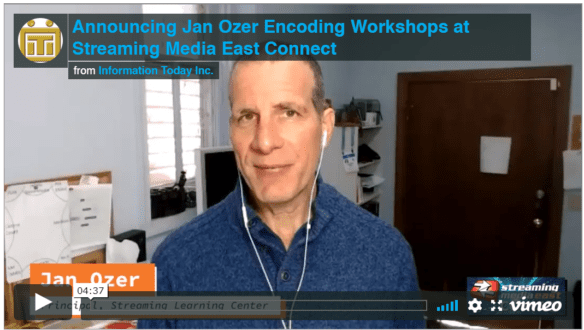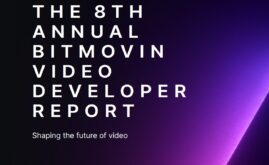Here are descriptions of the two courses I’ll be teaching in a few days on streaming media production.
Streaming Media East will be held online, with five 3-hour pre-conference training sessions that cost $199 each and a robust assortment of free 1-hour sessions. Here are the titles, dates, and times of the pre-conference sessions I’ll be teaching plus a short video describing the content and approach.
W1: Introduction to ABR Production and Delivery
Tuesday, May 26, 11:00 a.m. – 2:00 p.m. ET / 8:00 a.m. – 11:00 a.m. PT
Instructor: Jan Ozer
Description: This course helps those new to streaming media get familiar with the relevant terms, concepts, and technologies. The session begins with a definition of terms like codecs, container formats, and adaptive bitrate streaming, as well as encoding concepts like bitrate control (VBR, CBR) and frame types (I, B, and P). Then it details the key H.264 encoding parameters that impact quality and compatibility. Next up is adaptive streaming, including a review of available ABR technologies like HLS and DASH, how to formulate an encoding ladder, and how to use multiple DRMs to protect premium content. Then we’ll review the technical requirements for ABR delivery to computers, smartphones and tablets, OTT devices, and smart TVs, and finish with a quick look at advanced codecs like HEVC, VP9, AV1, VVC, and LCEVC. You walk away knowing the technical requirements for delivering to all key platforms and an understanding of how to do so.
W3: Key Encoding Skills, Technologies, and Techniques
Wednesday, May 27, 11:00 a.m. – 2:00 p.m. ET / 8:00 a.m. – 11:00 a.m. PT
Instructor: Jan Ozer
Description: This session helps encoding professionals get up-to-speed on crucial encoding-related issues, technologies, and techniques. Topics include:
- The best high-level strategies for delivering to computers, mobile, smart TVs, and OTT (which ABR, codecs, and DRMs are supported by which platforms)
- Current status of the H.264, HEVC, AV1, LCEVC, and VVC codecs; who’s using and where; comparative quality and encoding/decoding performance, and deployment schemas (DASH? HLS?)
- How to deliver HEVC over HLS
- Current status of per-title technologies for VOD and live encoding
- How to build/analyze your encoding ladder using objective quality metrics
- Current status of CMAF and its implications for delivering a single set of files to HLS/DASH players
- How to encode/deliver/protect with dynamic and static packaging
 Streaming Learning Center Where Streaming Professionals Learn to Excel
Streaming Learning Center Where Streaming Professionals Learn to Excel









